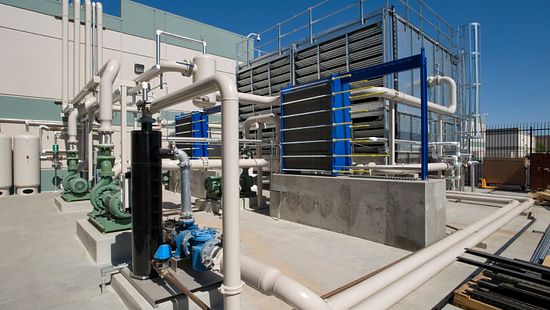Driving efficient water usage with innovative cooling water treatment solution
Wang Peng, PhD, Industry Technical Consultant of Nalco Water, SEA, examines efforts to rethink cooling water management best practices.
Providing an effective and cost-efficient cooling water treatment programme that increases water-use efficiency comes with its challenges. One such challenge lies in the excess contaminants that the cooling system typically absorbs. These contaminants stimulate bacteria and algae growth which, in turn, increases biofouling, scaling, and microbially induced corrosion. Other challenges that industrial cooling water users face include various incoming water conditions and more stringent industry/government regulatory requirements. Taken together, these factors can reduce system efficiency, raise overall operational costs, and risk non-compliance with local regulations or corporate sustainability goals.
Although phosphorus-based programmes have been widely used to control corrosion since chromate-based chemistry was banned in the 1980s1,2, the intrinsic properties of phosphorus as a microbiological nutrient and scaling pre-cursor have exacerbated these challenges.
Phosphorus-based treatment programmes require careful monitoring and often excess acid dosages to protect equipment and ensure system longevity. The pH, polymer and phosphate treatments that control scaling stress demand close attention. As programmes increasingly use alternate sources of makeup water, fluctuations in system calcium levels become more likely. These fluctuations affect the efficacy of the program: too little calcium and the programme provides insufficient corrosion protection, too much calcium and the potential to scale the system rises. Additionally, polymer requirements vary as the scaling potential changes.8 Overall, these cooling water challenges can negatively affect cooling system operations.
Additionally, phosphorus alone is an undesirable aquatic nutrient because of the potential microbial/algae growth it causes in both cooling water and natural water bodies.2-4 Unfortunately, over time, many non-phosphorus treatment programmes have achieved only moderate success.5,6,7 Non-phosphorus programmes have traditionally been hindered by narrow application windows, diminished performance, and high costs.
In recent years, some South East Asian countries such as the Philippines and Indonesia have adopted newer, stricter water regulations.3,4 In response, Nalco Water Southeast Asia has developed a new non-phosphorus (Non-P) programme that provides excellent corrosion and calcium carbonate scale control. This programme helps cooling water users comply with the increasingly stringent local phosphorus discharge regulations and minimizes discharge into natural bodies of water. Furthermore, the solution allows cooling water systems to reach higher cycles of concentration and operate at higher pH levels without compromising performance. With the programme’s ability to withstand high cycles (>10) and its long-holding time index (200 hours), it provides protection across a wider range of applications. It also offers superior performance in varying water conditions without adjusting dosages. By removing phosphate, Nalco’s non-phosphorus programme eliminates the aquatic nutrient that feeds harmful bacteria and algae, and therefore reduces microbially induced corrosion and waterborne pathogens.8
Case Study: Achieving solid results
One of the largest palm oil refineries in South East Asia needed to curb phosphorus-laden wastewater discharge. To comply with local environmental regulations, Nalco Water worked with the refinery to implement a non-P treatment programme. As Figure 1 illustrates, with the non-P programme, the cooling water discharge is now 100% compliant with local water discharge limits. The corrosion rate and microbiological activity also now fall well within an acceptable range. In addition, with less nutrients in the cooling water, the biocide consumption has reduced by an estimated 25%.

Figure 1. Phosphorus discharge is 100% compliant after employment of the non-P program
A leading IT company has a mega data centre located in Asia. For years, the data centre used a phosphorus-based cooling water treatment programme. In order to maintain high cycles of concentration and control scaling stress, the cooling water was continuously dosed with large amounts of sulfuric acid. With the Nalco Water non-P treatment programme, the pH control limit adjusted from 7.5 to 8.5 without noticeable scaling and fouling. Consequently, the consumption of sulfuric acid was reduced by approximately 55%. The corrosion rate for mild steel and copper also improved from approximately 1.7 and 0.1 mils penetration per year (mpy) to <0.2 mpy and <0.1 mpy respectively.
Moreover, the cycle of concentration increased, resulting in this data centre reducing its water consumption by 17% and achieving its corporate sustainability targets.
Reinventing the way water is managed.
Nalco Water’s new non-phosphorus cooling water treatment programme provides excellent corrosion control and calcium carbonate scale control, allowing different cooling water systems to reach increased cycles of concentration and pH levels without sacrificing performance. With its ability to withstand high cycles and long holding time index applications, this programme offers constant cooling system protections across a range of applications. Additionally, it provides superior performance in a variety of water conditions without changing the dosages. Non-P systems can operate in higher pH conditions, reduce acid consumption and avoid harmful bacteria and algae growth. Its broad application window allows it to tolerate fluctuations in the makeup water and tower without treatment changes.
References
1. Chen, B.Z. ‘A Robust Non-Phosphorus Corrosion and Scale Control Program for Cooling Systems’ Cooling Technology Institute, TP18-30, (2018).
2. REY, S.P., ‘Carbon Steel Corrosion Control in the Past Twenty Years and in the New Millennium,’ Paper given at AWT Conference (2000).
3. Department of Environment and Natural Resources, ‘Water Quality Guidelines and General Effluent Standards of 2016’, (2016).
4. Regulation of the State Minister of the Environment about Wastewater Quality for Businesses and/or Thermal Power Plant Activities, (2009).
5. POST, R.M., and TRIBBLE, R., ‘Development and Application of Phosphorus Free Cooling Water Technology’, Cooling Technology Institute (2014).
6. MOWBRAY. M., ‘Phosphorus elimination in cooling tower treatment program’, Hydrocarbon Process, (2015).
7. FELIPE, M.J., FULMER, D., SANDU, C., GUO, B.B., and NGUYEN, K., ‘Novel and Efficient Non-Phosphorous Cooling Water Corrosion Inhibitor’, Cooling Technology Institute, TP16-50, (2016).
8. MANTIS, A., CALLEJO, M., ‘Too Cool for Corrosion’, World Fertilizer, ADV-1852, (2019).

Download our White Paper about Water Considerations for Data Center Site Selection and Design in Southeast Asia
What are the significant findings from this paper?
Data center cooling systems rely on significant volumes of water to cool heat-producing servers efficiently. When evaluating a data center site, there are a number of critical water factors to consider, from country specific water availability, quality and regulations, to system design, material selection, sustainability and resiliency planning. While a data center is developed to last decades, it’s important to design your cooling system for future flexibility in terms of water systems and treatment. Each step in a data center’s development process from location to ongoing maintenance and management must consider the unique characteristics of the region.



